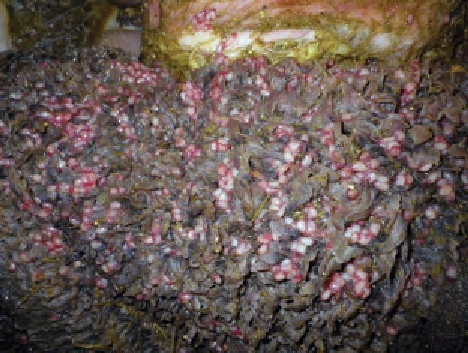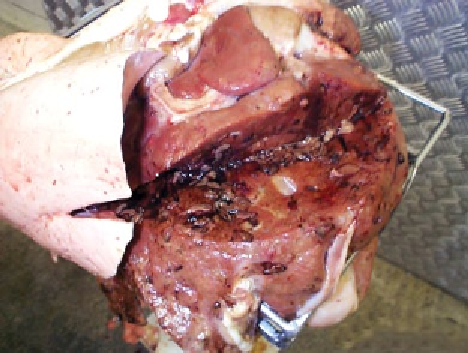Agriculture Reference
In-Depth Information
(a)
Figure 9.24
Paramphistomiasis, bovine rumen fluke.
(b)
1
Approved for human consumption
2
Totally condemned
3
Partially condemned
The category of
conditionally approved for human con-
sumption
is utilised in some countries: carcase meat
which is hygienically unsatisfactory or which in some
way may be hazardous for human and animal food is
treated, for example, by heating or freezing under official
supervision, in such a manner that makes it safe for
human consumption.
In certain regions, meat classed as
inferior meat
,
namely, safe hygienically but of a lower standard, may be
sold as raw meat without undergoing any treatment.
Such meat must be labelled so as to indicate that it is of
inferior quality and sold under close supervision by the
controlling authority. It includes meat of abnormal col-
our, odour or taste, with slight oedema or poorly bled
and, like the following category, is found in those coun-
tries where there is a scarcity of protein.
Lastly, meat may be
approved for human consumption,
with distribution restricted to limited areas
. This category
also occurs in those countries where meat is at a pre-
mium and includes meat from animals in an area under
quarantine because of an outbreak of contagious animal
disease. In this case, there must be no risk to public
health, and the meat must be restricted in sale to the
affected area to avoid the possible spread of disease. The
category would also include meat from animals vacci-
nated in a restricted area.
It is the duty of the official control staff to arrange for
the
health marking of the carcases
when passed and to
ensure the proper disposal of unfit material. It remains
important in Europe that checks to ensure the efficient
and hygienic removal of the SRM associated with BSE
from the carcase and viscera and their correct animal by-
product categorisation, marking and disposal.
Figure 9.23
Lesions of F. hepatica, liver fluke.
becomes infected by ingestion of mature sarcocysts, usu-
ally by eating contaminated meat of the intermediate host.
Humans may also serve as intermediate hosts and suf-
fer myositis and vasculitis, but this tissue phase is rare,
and the source of such human infection has never been
determined. Human intestinal illness, with clinical signs
of nausea, abdominal pain, and diarrhoea that lasts up to
48 hours, as followed ingestion of sarcocysts of
S. suihom-
inis
in uncooked pork and
S. hominis
in uncooked beef.
The extent of human illness from ingestion of infected
meat has not been documented, although the meat from
infected animals will be condemned on aesthetic grounds.
Courses of action
The
decisions made at post-mortem inspection
vary in
different parts of the world depending mainly on local
disease incidence, local economy and the presence or
absence of facilities for the heat treatment of meat condi-
tionally approved for human consumption. The main
decisions in most countries, however, are as follows:



